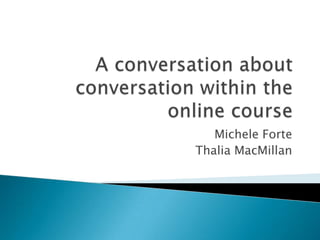
Conversations final
- 2. Asynchronous online courses ◦ Level of control: online versus face to face ◦ “Removed” presence
- 3. When students and the instructor are online – are they online at the same time? Does that matter? Instructor is guide on the side Sense of anonymity
- 4. People use the dinner party metaphor – that the instructor is the host What are the assumptions of a dinner party?
- 5. How do assumptions effect the guide-on- the-side theory? How do the assumptions of a dinner party effect co-hosting with students? Is it appropriate to stop a topic at a dinner party?
- 6. Human Services courses have their own particular rhythms, topics, conversations Courses deal with issues connected to historically disenfranchised individuals ◦ Some of whom may be students ◦ The conversations may be personal and volatile because they address issues of diversity and distribution of resources, etc.
- 7. In CHS, the responsibility for instructors is somewhat different than other areas of study as we need to speak to . . . : ◦ Human services guidelines ◦ Ethical frameworks ◦ Practical applications . . . . . all in our communications and potential training of students We sometimes ask ourselves – why is this student in CHS?
- 8. They have personal experiences ◦ From their own experiences ◦ Family member ◦ Close friend These experiences are unique and are brought to the course ◦ How do we highlight them and make each person’s experience heard? Need to name and talk about the experience in an academic setting (but not necessarily in an academic way)
- 9. What motivates a student to respond the way they do on discussion boards? ◦ Sound intellectual? ◦ Assumption about what something means ◦ Allegiance ◦ Try to ignore ◦ Not knowing how to talk about it?
- 11. Scenario 1: Hierarchical comments Scenario 2: Offensive comment Scenario 3: Bullying comment Scenario 4: Non-validation Scenario 5: Path of least resistance
- 12. Scenario 1: Hierarchical comments A student’s sister with MS and a classmate says that’s nice but my child has autism
- 13. Model an appropriate response Name the issue of hierarchy and point out how limited it is Connect the issue to course content or practical field experience Diffuse with positive solution
- 14. Scenario 2 – Offensive comment Student says “Why can’t people just feed their kids better – why don’t they care?!”
- 15. Try to hear what the student is saying Unpack the statement with respect to course content Seek a balanced response Reframe the problem Attend to statement and anticipate responses Ask an open-ended probing question
- 16. Scenario 3 – Bullying comment A student who makes comments to each and every person’s posting – trying to make their thoughts more prevalent than others
- 17. Assume that a student doesn’t know what he/she is doing or how it affects the conversation Provide ongoing formative feedback “Take it outside” - Talk to the student privately about the issue – name it
- 18. Scenario 4: Non-validation No one responds to a student’s thoughts on the DB OR “when a point has a thread of discussion and all of a sudden the point gets dropped by all”
- 19. Determine when did the student post to the DB As an instructor – raise points in the student’s posting and make it a conversation piece Highlight connections with other students Analyze why did the discussion stop ◦ Natural evolution? ◦ Offensive comment or a comment that no one could respond to?
- 20. Scenario 5 – Path of least resistance Students that may be nervous, afraid to correct, or engage a fellow classmate
- 21. Attend and anticipate problems ◦ Especially in the beginning of the semester Model an appropriate response Respond/reframe thoughts
- 22. Do we go off topic? ◦ Is that a bad thing? ◦ Is that a good thing? Does it derail, silence, or disrupt the conversation? Has it made the class come together more as a group or to each other?
- 23. Don’t make assumptions about student postings or intentions in postings Don’t be afraid to “name an issue” for students if it appears Reframe/redirect conversation if needed
- 24. Define what it means to “participate” online in a discussion board ◦ Not Facebook or text message ◦ Academic discourse ◦ Validate personal experience within the context of a larger academic conversation ◦ Don’t always have to agree with topics – couch within course content or outside material Engagement Validation
- 25. Summarize and comment on student postings Certain things you may need to “take it outside” Connect discussions to course content or outside examples within a larger professional context
- 26. When it comes to the discussion boards, better to be mindful than obsessed The dynamic of the conversation is important to learning and should be examined
- 27. Any questions??
